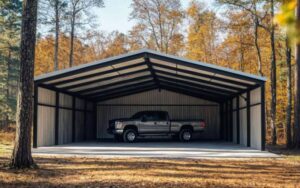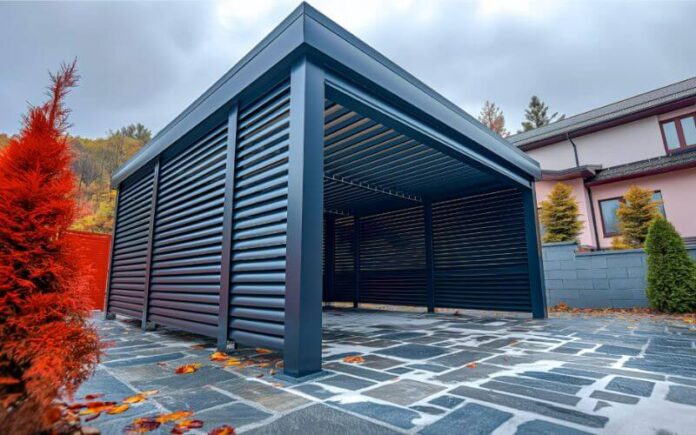Commercial carports offer businesses a practical solution for protecting vehicles, equipment, and outdoor workspaces from the harsh elements. These structures come in various sizes, materials, and configurations, making the selection process more complex than it might initially appear. Rushing into a purchase without careful evaluation may result in costly mistakes that fall short of operational requirements.
To help you out, here are key factors to consider:
Purpose of the Carport
The first step in selecting a commercial carport is defining its primary role. For some businesses, this structure may simply shield vehicles from sun, rain, and snow. In other cases, it may serve as a covered walkway for employees or customers, or as additional outdoor space for events and services. Understanding its intended use will help narrow down the right size, design, and materials.
Another consideration is the type of vehicles it needs to accommodate. A carport built for passenger cars may not suit delivery trucks, buses, or heavy-duty work vehicles. Clarifying the type and volume of traffic the carport will handle makes it easier to choose a design that provides the proper clearance and durability.
Material Options
Choosing the right material is one of the most important decisions when planning a commercial carport. It affects the overall appearance of the structure as well as how well it performs under daily use and varying weather conditions. Each material has unique advantages, and understanding these differences helps prevent unexpected issues later. Here are some of the most popular options:
Steel
This material remains a favorite choice in commercial settings because of its strength and resistance to harsh weather. With proper installation, steel buildings can withstand heavy use for many years without demanding extensive upkeep. Just make sure to invest in steel carports from reputable suppliers to get the most value from your purchase.
Aluminum
Lightweight and naturally rust-resistant, aluminum is well-suited for areas with high humidity or frequent rain. Its low weight makes it easier to install than heavier materials while providing reliable protection for vehicles and equipment.
Wood
Wooden carports bring a natural and attractive appearance that enhances the visual appeal of many properties. They’re often chosen for settings where aesthetics play a key role. However, wood needs regular sealing or painting to prevent damage from moisture, insects, and sun exposure, which can increase long-term maintenance costs.
When choosing materials, it’s essential to consider the local weather and the amount of wear the structure will face over time. It also helps to consider how much maintenance the business can manage in the long run.
Design and Style
A carport doesn’t have to be purely functional. Its style should complement the property’s existing architectural design. Some businesses prefer a simple, industrial look, while others may want a more polished structure with decorative elements. The right style can contribute to the overall impression customers and clients have when visiting the property.
Customization options are widely available. From the shape of the roof to the type of supports used, every detail can be adjusted to fit the business’s space and branding needs. Making design choices that align with both function and aesthetics ensures the carport enhances the site rather than appearing as an afterthought.
Size Requirements and Space Planning
Accurate measurements prevent frustration after installation. Buyers should account for not just the vehicles or equipment themselves, but also the clearance needed for safe maneuvering. A tight fit might seem cost-effective initially, but it creates operational headaches and potential damage risks.

Future growth deserves consideration as well. Businesses often expand their fleets or change their equipment over time. Investing in a slightly larger structure now can prove more economical than adding another carport later or replacing an undersized one. Allowing for flexibility in the layout ensures the carport remains useful for many years.
Local Regulations
Before moving forward with a commercial carport, it’s necessary to confirm the area’s zoning laws, building codes, and permit requirements. Regulations can dictate everything from the carport’s height to its placement on the property. Ignoring these rules can result in penalties or even the need to dismantle the structure.
Engaging with local authorities or a licensed contractor early in the process helps identify the required paperwork and approvals. This step not only avoids legal problems but also ensures the carport is built safely and up to standard.
Installation and Building Timeline
The delivery and installation can impact business operations. Some carports can be assembled quickly with minimal disruption, while more complex designs may take weeks to complete. Factoring in the timeline is essential, especially if the carport will be installed in a high-traffic area where business activity continues during construction.
Professional installation is usually the best route for commercial projects. Experienced builders ensure the structure is stable and compliant and can also handle unexpected challenges during the process. While hiring professionals adds to the cost, it often prevents delays and mistakes that could become more expensive later.
Price Point and Budget
Cost is naturally a key factor in the decision. Beyond the upfront price of the carport, businesses should also account for installation fees, permits, and potential maintenance expenses over time. A lower initial cost may not always be the best value if it results in higher long-term upkeep or shorter lifespan.
Budgeting for quality pays off. A durable carport with minimal maintenance needs often proves more cost-effective over the years than a cheaper structure that requires frequent repairs or replacement. Considering both immediate and future expenses provides a clearer view of overall value.
Warranty and Customer Support
A warranty can provide peace of mind and protect against unexpected issues. Coverage length and terms vary between manufacturers, so it’s important to read the fine print carefully. Some warranties may only cover certain components or exclude damage from extreme weather.
Beyond warranty, customer service or support is another factor worth noting. Responsive service from the supplier or builder can make a big difference if problems arise after installation. Companies that stand behind their products and offer reliable assistance often prove to be better partners in the long run.
Key Takeaway
A commercial carport can be valuable to any property, offering protection, convenience, and visual appeal. Choosing the right structure shouldn’t be rushed; it requires thoughtful consideration of several factors, from materials and size to installation and maintenance. Each of these elements plays a big role in how well the carport performs over time and how effectively it meets the business’s specific needs.
When all these aspects are carefully planned, it becomes a dependable investment that continues to provide value well into the future.


